Tactical missile system 2K6 "Luna"
Preliminary work on a promising missile system with improved performance began in the 1953 year. Specialists of the Research Institute-1 (now the Moscow Institute of Thermal Engineering) under the direction of N.P. Mazurov, who already had some experience in creating tactical missile systems. In the perspective project it was planned to use the existing experience, as well as some new ideas. With their help, it was supposed to improve the basic characteristics, first of all, the firing range. In parallel with the Scientific Research Institute-1, the creators of nuclear weapons studied the new problems. Their research has shown that with the current level of technology, it is possible to create a tactical nuclear warhead that fits in a rocket body with a diameter of no more than 415 mm.
In 1956, in accordance with a decree of the USSR Council of Ministers, a full-fledged development of a new project was launched. Prospective missile system received the designation 2K6 "Luna". In the very near future it was necessary to design a new system, and then submit prototypes of various components of the complex. Thanks to the extensive use of existing products and existing experience, the project was designed and protected by May 1957.
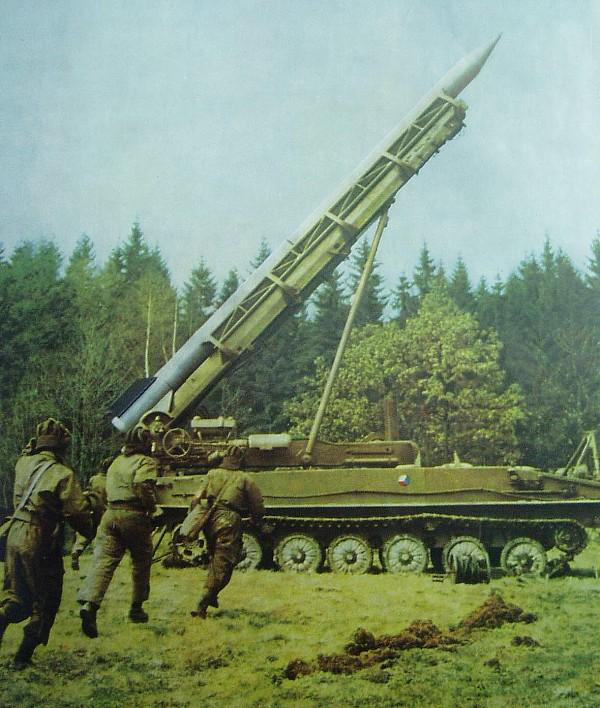
Complex 2K6 "Moon" in the army. Photo Russianarms.ru
As part of a promising missile system, it was proposed to use a set of various products and components. The main vehicle of the Luna complex was to become the self-propelled launcher S-125A Pion. Subsequently, she received the additional designation 2P16. It was also proposed the use of self-propelled charging system S-124A. These two vehicles were to be built on the basis of a lightweight floating tracked chassis. tank PT-76 and differ in the composition of special equipment. Also, along with tracked armored vehicles, several types of wheeled vehicles were to be operated: transporters, cranes, etc.
The development of a self-propelled launcher and transport-charging vehicle was assigned to the Central Research Institute-58. As a basis for this technique, it was proposed to use the PT-76 tank chassis. It was a tracked armored vehicle with light bulletproof and splinterproof armor, built according to the classic layout. In connection with the tactical role of the base tank, the chassis was equipped not only with crawler propulsion, but also with fodder water cannons for moving through water. During the restructuring of the new projects, the chassis should have received a set of necessary units.
In the aft compartment of the chassis there was a B-6 diesel engine with 240 horsepower. With the help of a mechanical transmission, torque could be transmitted to the drive wheels of the tracks or to the jet propulsion units. As part of the chassis there were six road wheels on each side. Used individual torsion suspension. The power plant and chassis allowed the floating tank to reach speeds of up to 44 km / h on land and to 10 km / h on water. In the role of a self-propelled launcher, the tracked chassis differed slightly in its mobility, which was associated with the need to reduce the negative impacts on the rocket being transported.
During the re-equipment of the new project, the existing chassis was deprived of the original combat compartment, in the place of which some new units were placed, including the places of some crew members. The 2P16 launcher could carry a crew of five people controlling it. The bulk of the new units were mounted on the roof and hull stern sheet. So, on the inclined front plate were hinged fasteners for the supporting device of the launcher, and on the stern there were jacks to hold the machine in the desired position during the shooting.
The design of the C-125A machine launcher was based on ideas previously used in the Mars 2K1 project. On the pursuit of the roof was placed the turntable, which reached the aft of the hull. In the stern of its part there were supports for the hinge installation of the launch guide, and in the front there were drives of vertical guidance. Launcher drives allowed targeting within a horizontal sector 10 ° wide. The maximum elevation angle was 60 °.
On the turntable was installed swing guide for the rocket. It was made in the form of a main beam with a length of 7,71 m, connected to additional side restraints. To connect the three beams of the launch guide, parts of complex shape were used, with the help of which the rocket stabilizers were allowed to pass freely. Such a guide design, as in the case of the Mars complex, gave the launcher a distinctive appearance.
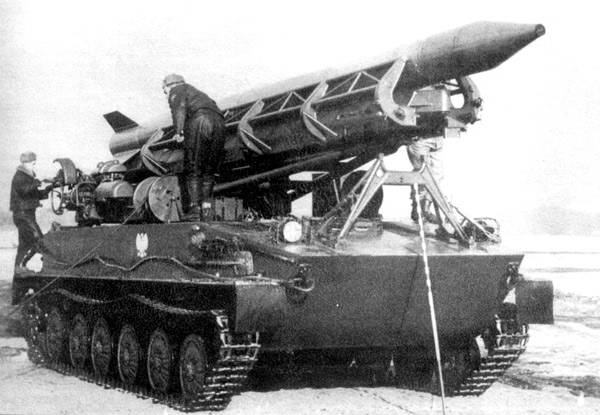
Launcher with rocket. Photo Defendingrussia.ru
The self-propelled 2P16 launcher was supposed to have a combat mass within 18 t. Later, due to some modifications, this parameter was repeatedly changed downwards. An armored vehicle without a rocket weighed no more than 15,08 tons. The artillery unit and ammunition, depending on its modification, accounted for no more than 5,55 tons of machine weight. Having a 240-strong engine, the launcher could reach speeds up to 40 km / h on the highway. At the same time allowed the transport of missiles. To avoid rocket damage, the speed on rough terrain should not exceed 16-18 km / h.
The C-124A charging machine instead of the launcher was supposed to receive funds for transporting two Luna missiles and a crane for reloading them to the launcher. Maximum unification of the chassis allowed without any problems in parallel to operate the armored vehicles of two types for different purposes. In addition, the joint work of the TZM and the launcher was to ensure the combat use of rocket weapons.
For use by the 2K6 “Luna” complex, two types of unguided ballistic missiles were developed - 3P9 and 3P10. They had the highest possible unification, differing in the type of combat units and, as a result, in their purpose. Both rockets had a cylindrical body with a diameter of 415 mm, inside of which a two-chamber solid-fuel engine of type 3Ж6 was placed. As in previous projects, the engine had two separate chambers placed one after the other inside the case. The head chamber of the engine received a set of nozzles arranged with an inclination and venting gases to the sides of the body, as well as spinning up the rocket, and the tail had a traditional nozzle apparatus giving a thrust vector parallel to the axis of the product. Two chambers were loaded with solid fuel charges with a total weight of 840 kg. This supply of fuel was enough for 4,3 from work.

Launcher and transport-loading machine. Photo Militaryrussia.ru
On the tail part of the body were placed four trapezoid stabilizers. To maintain the rotation of the rocket in flight, the stabilizers were installed at an angle and could spin the product under the pressure of the incoming flow. Scope of the stabilizer - 1 m.
Rocket 3P9 received caliber high-explosive warhead. Inside the case with a diameter of 410 mm with a conical head fairing placed a charge of explosive. The total weight of such a warhead was 358 kg. The length of the product 3P9 was 9,1 m, the starting weight - 2175 kg. The rocket with a high-explosive warhead, differing in relatively low weight, had a greater maximum speed, which had a positive effect on the firing range. With the help of the 3P9 rocket, it was possible to hit targets at ranges from 12 to 44,5 km. The circular deviation probably reached 2 km.
For the 3P10 rocket, a special combat unit, 3H14, was developed with a charge of type 901А4, created in KB-11. Due to the limitations imposed by the nuclear warhead, the warhead had an increased maximum diameter and a different shape. In the case with a conical fairing and a tail part in the form of a truncated cone, having a maximum diameter of 540 mm, was placed a warhead of power 10 кт. The mass of the product 3Н14 was 503 kg. Due to the large over-caliber warhead, the length of the 3Р10 rocket reached 10,6 m, the launch weight was 2,29 t. A special electric heated case was developed for use with a rocket equipped with a special warhead to maintain the required storage conditions for the warhead.
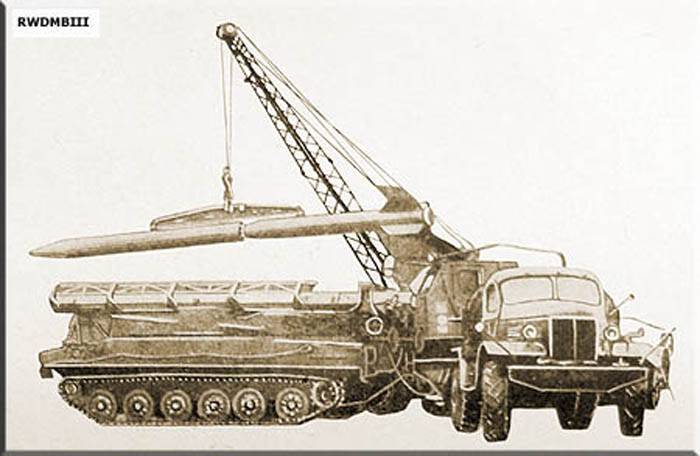
Installing the rocket using a crane. Photo Militaryrussia.ru
The increase in mass compared to a non-nuclear product adversely affected the main characteristics. On the active segment of length 2 km, the 3Р10 rocket picked up speed, allowing it to hit targets at ranges of no more than 32 km. The minimum firing range was 10 km. The accuracy parameters of both missiles were similar, but in the nuclear 3P10, the high QUO was partially offset by the increased power of the warhead.
The missiles did not have control systems, which is why their targeting was carried out using a launcher. Due to the impossibility of changing the parameters of the engine, the firing range was regulated by the elevation angle of the guide. Deploying the launcher after arriving at the firing position required no more than 7 minutes.
To support the combat work of tactical missile systems 2K6 "Luna" a mobile repair and technical base PRTB-1 "Step" was developed. The base included several vehicles with various equipment that could carry missiles and combat units, as well as assemble them in field conditions. The development of the Step project began in SKB-211 of the Barricades plant in the spring of 1958. The following year, the project reached the stage of building prototypes. Initially, the “Step” complex was proposed for use with the 2K1 “Mars” missile complex, but the limited release of the latter led to the fact that the mobile base began to work with the “Luna” missiles.
In the spring of 1957, the development of the main elements of a promising missile complex was completed. In May, the Council of Ministers decision on the construction of experimental equipment and its subsequent tests was issued. The following year, several enterprises engaged in the Luna project presented new types of products for testing. In 58-m began testing new missiles and ground testing of the latest technology. The main checks were carried out at the site Kapustin Yar.
In the autumn of 1958, the composition of the equipment included in the missile complex was revised. In the course of the visit, the first persons of the state received an order to refuse further work on the transport-charging vehicle. High-ranking officials considered this sample superfluous and leading to an unacceptable increase in the cost of the complex. In the spring of 59, the technical task for the development of the transport machine 2У663 appeared. It was a ZIL-157В tractor with a semi-trailer equipped with mounts for carrying two 3P9 or 3P10 missiles. A semi-trailer 8Т137Л was also created, which was not tested due to insufficient strength. In the early sixties, an improved version of the transporter appeared with the designation 2U663U.
In accordance with the new guidelines, maintenance of the launchers was planned to be carried out with the help of auxiliary equipment based on wheeled trucks. It was proposed to transport the rocket to the reloading position with the help of semi-trailers, and the reloading should be carried out by a mobile crane. With some problems and drawbacks, such an approach to the operation of the missile complex made it possible to save on the production of full-fledged TZM on a tracked chassis.
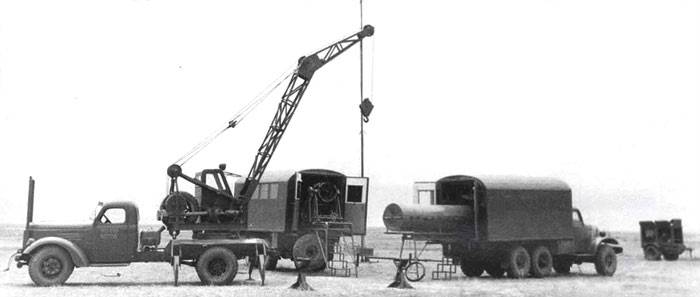
Mobile rocket-technical base PRTB-1 "Step" at work. Photo Militaryrussia.ru
At the end of the fifties, an attempt was made to develop new self-propelled launchers based on existing wheeled chassis. Thus, in the project Br-226, it was proposed to mount the launcher on a four-axle floating machine ZIL-134 or on a similar chassis ZIL-135. Both versions of the launcher, which received the designation 2P21, were of some interest, but did not leave the test stage. They appeared too late for the customer to consider them an acceptable replacement for the original tracked vehicle. The development of the second version of the wheel launcher was discontinued due to the appearance of the Luna-M project.
During 1958, industry and military experts conducted all the necessary tests of new equipment and rockets. Inspections at the Kapustin Yar test site revealed a list of necessary improvements. In particular, there were claims to the combat mass of 2P16 vehicles. By the time of the start of mass production, the weight of this technology with a rocket was reduced to 17,25-17,4 t. After all the modifications, the rocket complex again needed some checks, including conditions close to real ones.
At the beginning of 1959, an order was issued to send several tactical missile systems 2К1 "Mars" and 2К6 "Luna" to the Aginsky training ground of the Trans-Baikal Military District. During such checks, self-propelled cars of two types showed their capabilities on the existing routes, and also conducted missile launches. The Luna complex used up six rockets, proving it was possible to work in adverse weather conditions and at low temperatures. At the same time, according to test results, a new list of requirements for upgrading equipment and missiles has appeared.
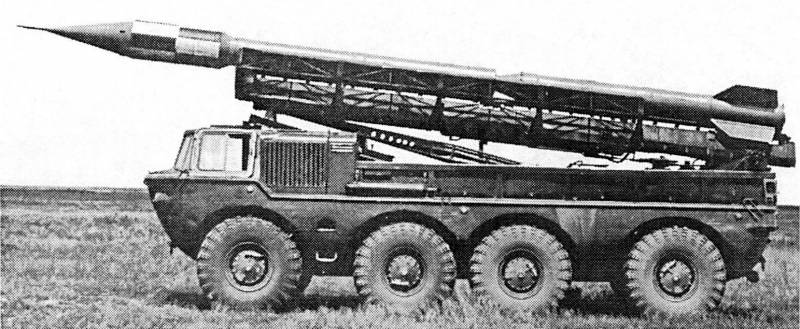
Experienced self-propelled launcher Br-226. Photo Shirokorad AB "Domestic mortars and rocket artillery"
In the spring and summer of the same year, tests of the modified 3P9 and 3P10 missiles, characterized by increased accuracy and greater reliability, were tested. In addition, the refinement of self-propelled vehicles used as part of the missile complex was conducted in parallel. By the end of the year, the Luna complex had reached an acceptable state, which led to the appearance of a new order from the customer, this time about the release of serial equipment.
In the last days of December, 1959 of the year issued a decree of the USSR Council of Ministers on the start of mass production of new equipment. By mid-January next year, the plant "Barricades" was supposed to submit the first five sets of equipment. This technique was planned to be sent to state trials. In that period, the industry presented the required number of self-propelled launchers, transport vehicles, truck cranes, etc.
From January to March 1960, prospective systems were tested at several test sites in the Moscow and Leningrad Region. Some polygons were used as a route for inspections, while others were involved in firing. During the test, about 3 thousand km passed. Also 73 fired two types of missiles. According to the results of state tests of the tactical missile system 2K6 "Luna" was adopted by the missile forces and artillery.
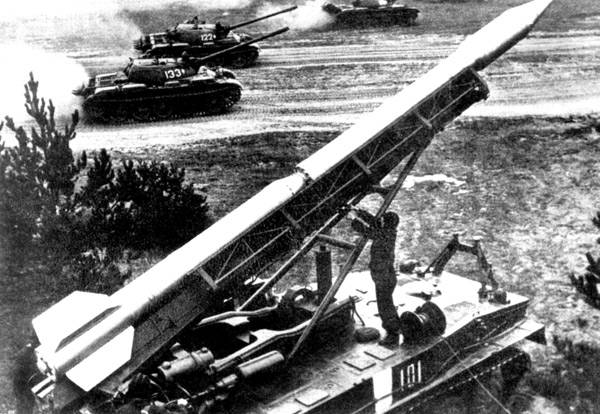
Preparation of the complex "Moon" to launch a rocket during exercises. Photo Russianarms.ru
By the end of 1960, the Barricades factory launched the 80 2P16 self-propelled launchers. It was also planned to release hundreds of 2U663 transport vehicles, but only 33 was built. Production of the Luna complexes continued until the middle of 1964. During this time, according to different sources, from 200 to 450 launchers and a certain amount of auxiliary equipment were built. Deliveries to the ground troops began in the year 1961. Rocket battalions consisting of two batteries were formed specifically for the operation of the Luna complexes in tank and motorized rifle divisions. Each such battery had two Tulip 2P16 machines, one 2U663 transporter and one truck crane.
In October, the 61 th missile unit from the Carpathian Military District took part in exercises in Novaya Zemlya, during which five 3P10 missiles were fired, including one with a special warhead. During these exercises, the 2K6 "Luna" complex was used together with the mobile repair and technical base of the PrTB-1 "Step".
In the autumn of 1962, 12 Luna complexes with ammunition in 60 missiles and a number of special combat units were delivered to Cuba. Later, apparently, this technique was transferred to the army of a friendly state, which continued its operation. There is information about the completion of launchers and missiles. The exact nature of these modifications is unknown, but the surviving samples have some noticeable differences from the original systems of Soviet production. As for the special combat units, they were removed from Cuba after the end of the Caribbean crisis.
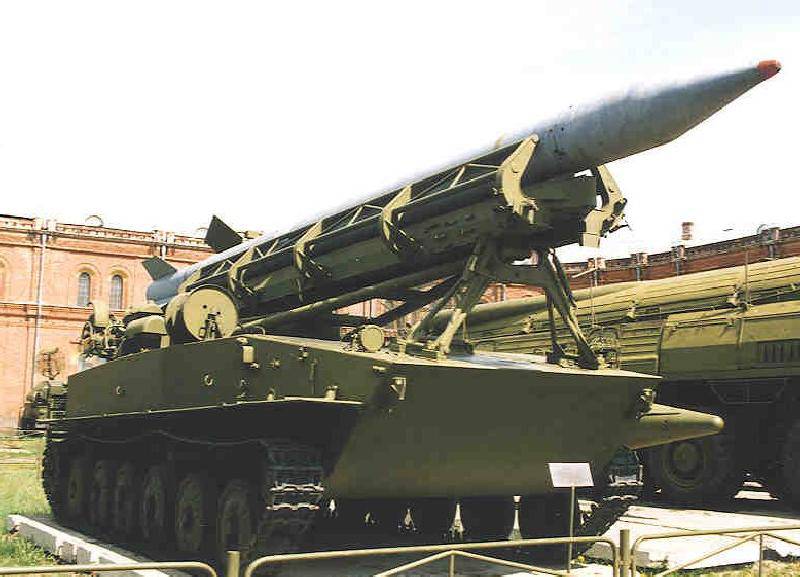
Museum sample machine 2P16. Photo Russianarms.ru
Shortly after the Cuban events, the first official public demonstration of the Luna complex took place. During the parade on Red Square on November 7, several samples of the 2P16 launcher with missile models were shown. In the future, similar equipment repeatedly participated in parades.
After completing the order of its own armed forces, the defense industry began production of the 2K6 “Luna” complexes in the interests of foreign armies. In the sixties and seventies, a certain amount of such equipment was transferred to a number of friendly states: the GDR, Poland, Romania and the DPRK. In the case of North Korea, 9 launchers were delivered with the necessary auxiliary equipment and missiles with conventional warheads. In Europe, deployed complexes with missiles of both compatible types, but the special combat units were not transferred to the local military and were in the vaults of Soviet bases.
Soon after the adoption of the Luna complex, its modernization was launched. Three years later, an improved Luna-M 9K52 system was put into service. The development of rocket technology, the emergence of new complexes and the development of promising technologies led to the fact that over time, the Luna system in the initial configuration ceased to meet the existing requirements. In 1982, it was decided to remove this complex from service. Operation of such technology in foreign armies continued later, but also eventually ceased. According to some information, now the 2K6 "Luna" complexes remain in service only in North Korea.
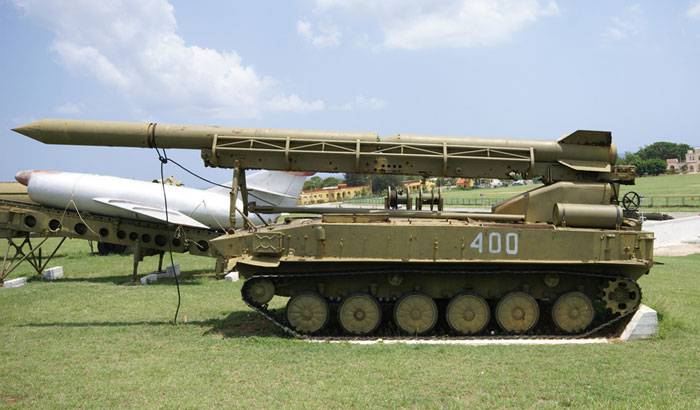
Self-propelled launcher, modified by Cuban experts, in the museum of Havana. Photo Militaryrussia.ru
After the removal and decommissioning of most of the machines, "Luna" went for recycling. Nevertheless, in several domestic and foreign museums there are exhibits in the form of 2P16 machines or 3P9 and 3P10 rockets. Of particular interest is the exhibit stored in the Museum of Military Equipment of Havana (Cuba). Previously, it was operated by Cuban troops, and also underwent some refinement by local specialists. After working out the resource, this car went to the museum for eternal parking.
The 2K6 "Luna" with the 2P16 "Tulip" launcher, as well as the 3P9 and 3P10 missiles, became the first domestic tactical missile system to reach full-scale mass production and mass operation in the troops. The appearance of such equipment with sufficiently high characteristics in the required quantities allowed for a full-fledged deployment with a noticeable impact on the strike potential of the troops. The "Moon" project allowed to solve the existing problems, as well as create a reserve for the further development of rocket weapons. Some of the ideas embodied in it were subsequently used to create new tactical-level missile systems.
Based on:
https://defendingrussia.ru/
http://dogswar.ru/
http://militaryrussia.ru/blog/index-244.html
Shirokorad A.B. Atomic ram of the twentieth century. - M., Veche, 2005.
Shirokorad A.B. Domestic mortars and rocket artillery. - Mn., Harvest, 2000.
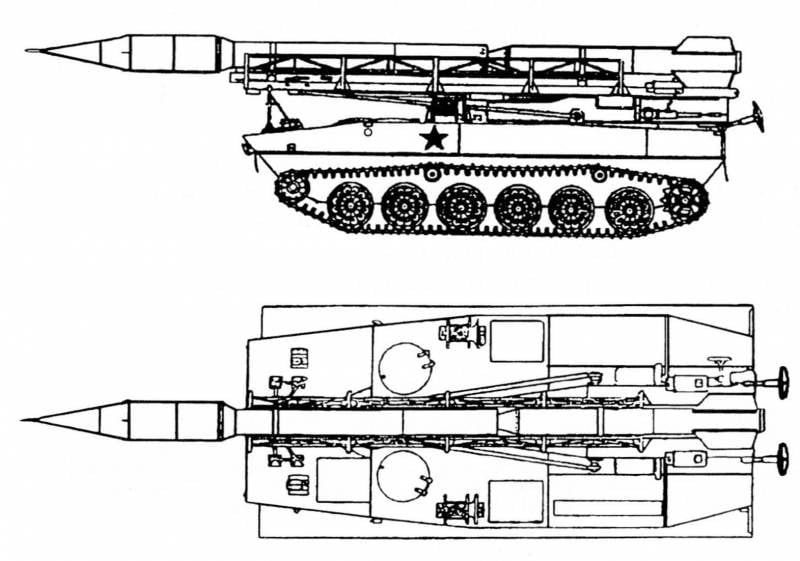

Information